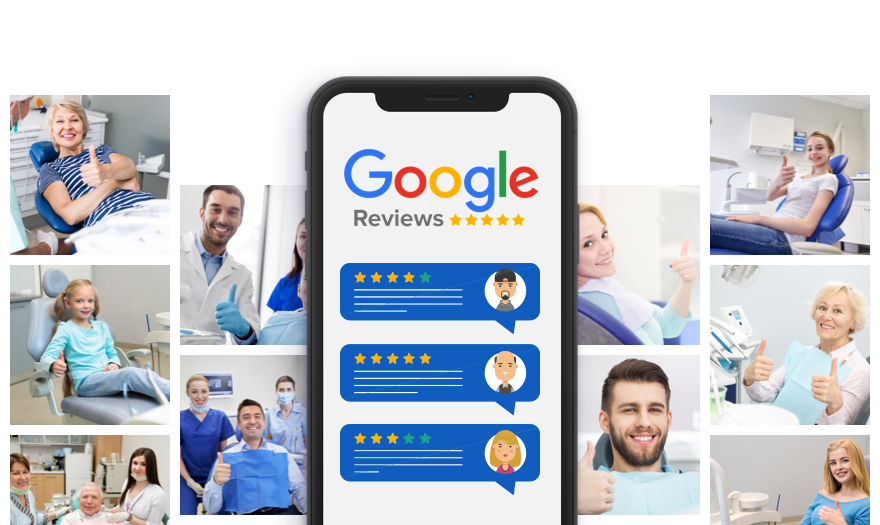

Not only are reviews essential when it comes to your ranking on Google, but they’re also crucial for attracting new clients and retaining the old ones. Did you know that reviews are the most important ranking factor for all local searches!
Over 86% of consumers read reviews for local practices and businesses before deciding whether they should visit them, or buy their product or service.
So, if you want to ensure the success of your dental practice, getting more reviews on Google is essential.
Sometimes this is easier said than done, so let’s check out some sure ways that’ll get you more reviews on Google.
Are You Going Above and Beyond For Your Customers
Generally speaking, you’ll mostly get reviews only if your patients were delighted with your services, or if they had a bad experience. Those in the middle ground are much less likely to post any reviews whatsoever. This is why you’ll mostly see a majority of 5-star or 1-star ratings, with few others scattered in between.
So, if you want reviews, you have to go above and beyond for your patients. Utmost customer satisfaction is key.
From a smooth and effortless booking process, to a clean and entertaining waiting room to an efficient and professional service, there are hundreds of ways that a practice can provide a pleasant experience for their patients. The great part about asking for more reviews is that you will get direct feedback on what a patient liked and didn’t like and you can always adjust your processes from there if you start to see a trend.
Unfortunately, regardless if you do everything in your power to please a patient, there are always a few sour apples that are impossible to please. This doesn’t mean you should stop trying.
Have You Identified the Review Networks That Are the Most Popular in Your Industry?
Knowing the most popular review networks for dental practices is a must for a few different reasons. Primarily, you’ll get to learn more about the competition, find out what they’re doing right and what they’re doing wrong. This can especially be helpful to those who’ve just recently opened their practice, and who need to learn more about what the patients like and what they don’t.
Secondly, even if you don’t have a profile on some of the more popular review networks, it doesn’t mean no one’s reviewed you there.
On many social platforms, dissatisfied customers can easily make a profile for you based on your publicly available information. Ensure that this doesn’t happen by identifying the popular review networks and creating profiles on them.
One insider trick that will get you started is to search for your practice or one of the more popular practices in the city. From there have a look near the bottom of the Google My Business side bar and it will highlight the review networks that Google is registering with the profile. These networks are the ones you will want to focus on.
In general the most important review platforms that a dental practice should focus on are: 1. Google 2. RateMD 3. Facebook, in that order.
Have You Identified the Most Opportune Moment to Ask Customers for a Review?
Over 70% of consumers will leave a review when asked, and there’s nothing wrong with asking your patients for a review. What is almost as important as making the ask for the review is the timing at which you are making your asks.
For example, if Jenny just came to your practice and had a procedure that required them to be sedated or has a significant recovery time, you will want to avoid asking them to leave you a review until you know they have fully healed and no longer have their head in the clouds from the anesthesia!
If a patient just came in for a regular cleaning, you will find yourself getting the best results if you ask within 24 hours they likely still have that freshly cleaned teeth feeling!
In short, don’t wait long after the patient has been in through your doors to ask for a review, the sooner the better.
Are You Sending out Requests, as Well as Friendly Reminders?
If your patient hasn’t left a review after you’ve asked them to in person, you can send them an email as a friendly reminder. A short email thanking them for making an appointment with you, and reminding them to leave a review on a certain website should work perfectly.
Unfortunately, as everyone’s lives are busy and often chaotic, even if your patient had full intent on going home and leaving a review, something likely came up on the drive home and derailed their train of thought and have now forgotten about leaving you a review. This is why having a follow up process for those who have not yet taken action to leave a review is essential for collecting a steady stream of positive reviews.
We have found that the majority of those who leave reviews do so on the 2nd or 3rd ask.
That being said, you don’t want to overwhelm you patients with requests for reviews so space out your asks accordingly. What we have found works best is to follow up on your first request after a 3 day period and then follow up once more 4 more days after your second review.
If at that point they have still not left you a review, it likely means they don’t have any intention on doing so and in that case, we would stop asking them until they came back to for another appointment.
Do You Have a System to Monitor Recent Reviews?
Monitoring recent reviews will allow you to keep track of your progress, and act quickly if you receive negative feedback. You will also be able to get a good understanding of the general thoughts and reactions of your patients with recent reviews.
For example, if you notice that a handful of reviews recently commented on the wait time being a little longer than they would have liked, you can figure out what is causing these delays and aim to put and end to them.
Moreover, 40% of consumers will only look at reviews written in the past 2 weeks, and if they notice that negative comments aren’t being addressed, your dental practice will seem unprofessional. This leads well into my next recommendation.
Are You Responding to All Reviews?
Whether it’s positive or negative, if you want to leave the right impression, you have to respond to all of your reviews.
This allows you to promote your dental practice, as each of your patients will feel valued and respected. Anyone who sees the reviews and your responses will be more likely to visit your practice since you’ll appear more trustworthy.
Thank your patients who’ve left a positive review, and address the issues mentioned in the negative ones. You have to be careful when responding to dissatisfied patients, however.
Stay humble, respectful, and professional. Apologize for any inconvenience caused, and show that you understand their point of view and that you want to make it right. Don’t ever get in an argument within your reviews, even if what was said in the review was completely erroneous, ask for the patient to contact you personally offline and work with them to come to a fair conclusion in a private manner.
In the grand scheme of things, the rare negative comments can actually be great for your dental practice since they’ll show your reviews are completely authentic and that if a patient isn’t satisfied, you are going out of your way to resolve the issue. In some cases, that is worth more than a positive review.
The Bottom Line
Good reviews will help your dental practice succeed on all levels, so it’s a good idea to invest some time and energy into ensuring you get them on a regular basis.
The most important thing to keep in mind is that the better patient care you provide, and the better your services are, the more people will want to recommend your dental practice to others, and the more people will leave reviews.
So, your primary focus should be patient care, and then creating the routine to reach out to your patients with the goal of consistently building upon your online reputation.
If you want to learn more about how we can help you grow your dental practice, check out our Dental Marketing Overview.
If you don’t know where to start or wish there was a system that takes care off all of this for your.. you’re in luck as we can help! Contact me any time and we can have a chat.




